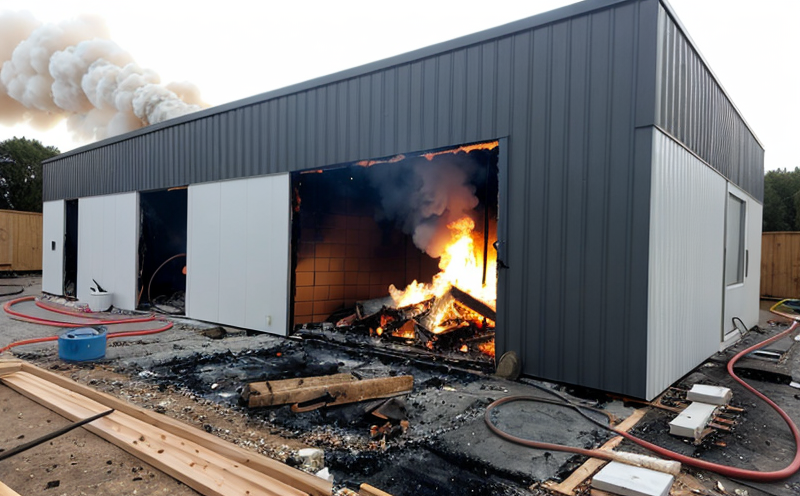Thermal Barrier Performance under Fire
The integrity and performance of thermal barriers in fire situations are critical to safeguarding lives and property. Thermal barriers are designed to prevent the spread of flames, reduce heat transfer, and provide a time delay for fire spread, thereby protecting occupants and structures during emergencies.
Thermal barriers, commonly found in building materials such as insulation boards or cladding systems, play a pivotal role in mitigating the impact of fires. The performance under fire is evaluated through rigorous testing that simulates real-world scenarios to ensure compliance with regulatory standards and safety requirements.
The testing process involves subjecting samples of the thermal barrier material to controlled fire exposure conditions. This allows us to measure the effectiveness of the barrier in resisting flame spread, maintaining structural integrity, and minimizing heat transfer. The results provide crucial insights into the material's performance, which is essential for ensuring compliance with relevant codes and standards.
Testing typically involves the use of a variety of apparatus designed to simulate fire conditions. These include furnaces capable of generating controlled flame exposures at specific temperatures and durations. Specimen preparation plays a critical role in these tests; it ensures that the samples accurately represent real-world applications, allowing for reliable performance assessments.
The testing procedure begins with careful selection and preparation of the specimen to be tested. The sample must replicate the actual material as closely as possible to ensure accurate test results. Once prepared, the specimen is subjected to controlled fire exposure in a chamber, where temperature and flame propagation are monitored continuously using advanced instrumentation.
During testing, critical parameters such as flame spread index (FSI), heat release rate (HRR), smoke production rate (SPR), and char depth are recorded. These metrics provide comprehensive insights into the barrier's performance under fire conditions. The data collected is then analyzed to assess the effectiveness of the thermal barrier in fulfilling its intended role.
Compliance with international standards such as ISO 1716, EN 13501-1, and ASTM E84 ensures that the tests are conducted in a consistent manner across different regions. These standards provide clear guidelines on test procedures and acceptable performance levels, ensuring that all stakeholders can rely on comparable results.
- ISO 1716: Determination of flammability - Test method for materials
- EN 13501-1: Fire resistance classification of building materials and products - Part 1: General requirements, fire tests using vertical test specimens
- ASTM E84: Standard test methods for surface burning characteristics of building materials
The results of these tests are used to inform design decisions, refine product specifications, and ensure compliance with local regulations. By adhering to these standards, we can provide clients with reliable data that supports informed decision-making processes in the development and implementation of fire safety strategies.
Applied Standards
The thermal barrier performance under fire is evaluated using a range of international standards. These standards are designed to ensure that the tests are conducted in a consistent manner, providing reliable and comparable results across different regions. The primary standards used for this service include:
- ISO 1716: Determination of flammability - Test method for materials
- EN 13501-1: Fire resistance classification of building materials and products - Part 1: General requirements, fire tests using vertical test specimens
- ASTM E84: Standard test methods for surface burning characteristics of building materials
These standards provide clear guidelines on the testing procedures and acceptable performance levels. By adhering to these standards, we can ensure that the tests are conducted in a manner that is both rigorous and consistent with global best practices.
Scope and Methodology
The scope of our thermal barrier fire testing service includes comprehensive evaluation of materials used as thermal barriers. This involves subjecting the samples to controlled fire exposure conditions in a laboratory setting, allowing us to assess their performance under realistic fire scenarios.
The methodology for these tests is carefully designed to replicate real-world conditions as closely as possible. Specimen preparation plays a critical role in ensuring that the samples accurately represent the actual materials used in construction or insulation applications. Once prepared, the specimens are subjected to controlled flame exposures using advanced instrumentation capable of measuring key performance indicators such as flame spread index (FSI), heat release rate (HRR), smoke production rate (SPR), and char depth.
The testing process is conducted according to internationally recognized standards such as ISO 1716, EN 13501-1, and ASTM E84. These standards provide clear guidelines on the procedures to be followed during testing and establish acceptable performance levels. The data collected from these tests are then analyzed to determine the effectiveness of the thermal barrier in fulfilling its intended role.
The results of these tests are used to inform design decisions, refine product specifications, and ensure compliance with local regulations. By adhering to these standards, we can provide clients with reliable data that supports informed decision-making processes in the development and implementation of fire safety strategies.
International Acceptance and Recognition
- Australia: Thermal barrier performance tests conducted according to AS 1530.1-2009, which aligns with international standards.
- New Zealand: Compliant with NZS 8460:2017 for fire resistance classification of building products and materials.
- United States: Tests conducted in accordance with ASTM E84, ensuring compliance with US regulations.
- Canada: Thermal barrier performance tests meet the requirements outlined in CSA A770-15, which aligns with international standards.
- European Union: Compliance testing according to EN 13501-1 ensures alignment with EU fire safety regulations.





